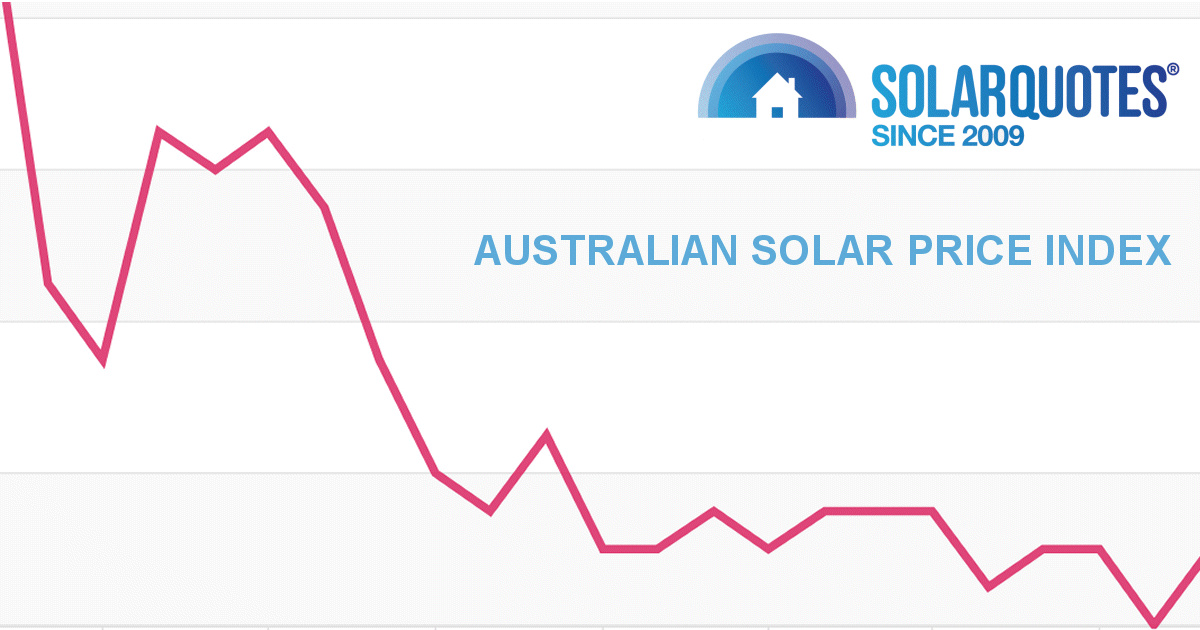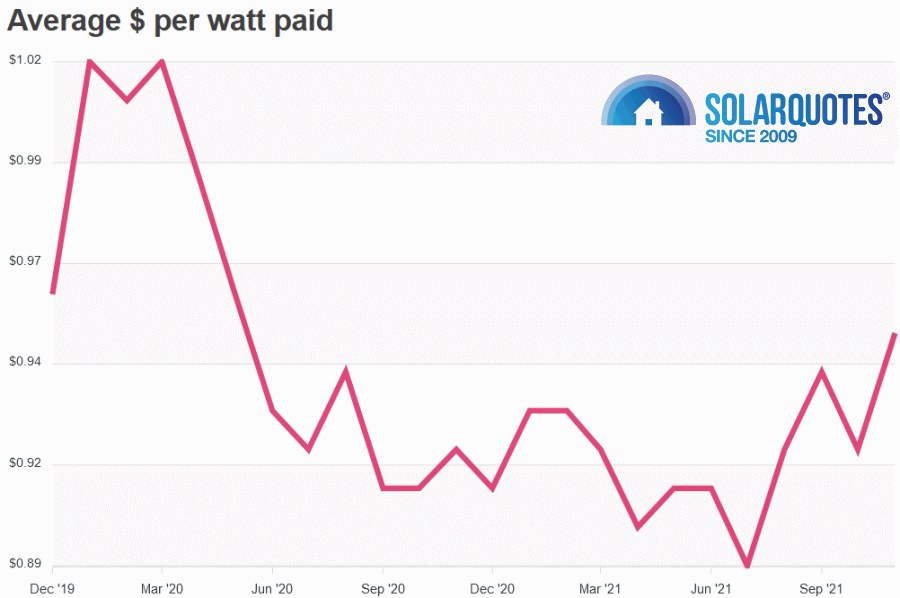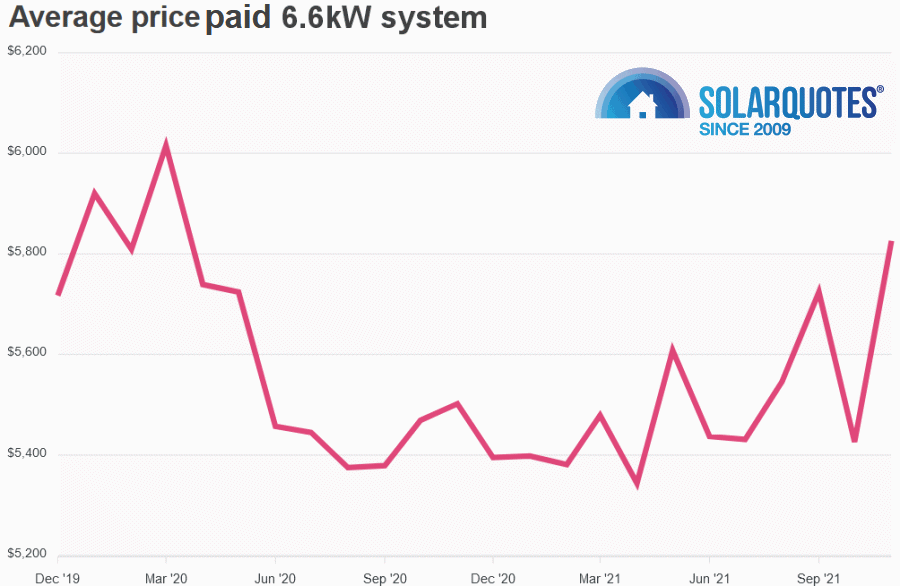The cost of home solar power systems increased across much of Australia in November, but not all states saw a price hike.
The following table indicates prices paid (cost per watt) across all system sizes and after all rebates/subsidies in November 2021 compared to October, and November 2020. The numbers for November are based on pricing information SolarQuotes received on 411 system purchases.
| State | Cost per watt (November 2021) |
Cost per watt (October 2021) |
Cost per watt (November 2020) |
| QLD | $0.93 | $0.88 | $0.89 |
| NSW | $1.02 | $1.02 | $1.01 |
| ACT | $1.25 | $1.10 | $1.00 |
| VIC | $0.99 | $0.86 | $0.86 |
| TAS | $NA | $1.08 | $1.21 |
| SA | $0.91 | $0.92 | $0.90 |
| WA | $0.81 | $0.77 | $0.71 |
| NT | NA | NA | $1.31 |
| AU | $0.95 | $0.92 | $0.92 |
And here’s an updated graph of the national cost-per-watt picture (all system sizes) going back to December 2019:
The following graph shows historical pricing on 6.6kW solar systems. While 6.6kw is still the most popular size, many Australians are choosing to install bigger systems; usually up to 10kW – which is around the maximum capacity that can be installed on an average residential rooftop.
The graphs are from SolarQuotes’ Australian Solar Price Index; an interactive tool based on information submitted to SQ in solar installer reviews that also include reviews of installers not associated with the SQ network. The figures above may change given the Index is updated as new reviews come in.
What Happened In November?
Prices appear to have really shot up in Victoria in November 2021 and to a lesser degree in Western Australia and Queensland. It’s harder to gauge smaller jurisdictions such as the ACT, NT and Tasmania due to the comparatively small amount of data we have on each.
The increases may reflect businesses in those states running on particularly thin margins and solar panel price hikes – which should be temporary – really starting to bite. Still, solar energy remains a solid investment in all three states, as it does across Australia.
There’s some potentially good news on the solar panel side of things. One of the drivers of price increases has been the cost of polysilicon, which is used in the manufacture of solar cells. Polysilicon spot prices topped out at more than USD $36/kg early December, five times the price prior to the pandemic and other events piling the pressure on.
But since early December polysilicon spot prices have dropped – down to around USD $32 last week. It still has a long way to go to get back to “normal” levels, but the outlook is good with a bunch of new production capacity coming online recently and in the not-too-distant future.
Something else perhaps coming into play towards the end of November has to do with the solar rebate; i.e. the up-front subsidy on installation. The level of subsidy reduces at the beginning of year. Given it’s based on when a system is installed rather than purchased, some sales in November would have been for an early 2022 installation.
Why It’s A Good Idea To Buy Solar Now
If you’re considering putting off installing panels for whatever reason, consider this centuries-old observation from Robert Burns:
“The best laid schemes o’ Mice an’ Men
Gang aft agley,
An’ lea’e us nought but grief an’ pain,
For promis’d joy!”
“Gan aft agley” translates to “often go awry”. Many Australians would have experienced plans winding up that way over the last couple of years.
But aside from something out of left field (or in line of sight) putting more spanners in the works; the longer a household puts off harvesting solar energy from their rooftop, the longer they are paying their electricity retailer far more than they need to for mains supply. Any savings made while waiting for solar system pricing to drop might be gobbled up by bigger electricity bills.




 RSS - Posts
RSS - Posts



Why is there such a difference in cost between states? I’m specifically concerned between Perth where I installed a 6.6Kw system mid 2021 and the cost for a similar system just quoted for another family home in inner Sydney? The Sydney installation is close to 100% more. Both systems were quoted through SolarQuotes.
Ray, it may have to do with the fierce competition in WA. But don’t worry, you still have FIT and you have maybe subsidy on batteries or on EV’s. Also, your batteries are not down throttled by your power company. We get robbed here of energy we make ourselves.
FIT is Perth from sunrise to 3PM is 3 cents / unit and from 3pm to sunset 10 cents, so miserable… Absolutely no subsidy on batteries in WA & as we all know no business case would support investing in batteries with their fast loss of capacity over time.
As I write this it is 40 degrees in Perth and for once I’ve never seen my Daiken ducted system actually importing about 1KWh during the day while using the full 5KWh from the solar panels. Typically I’m exporting 30KWh to the grid per day but not today. In WA we are limited to 5KW systems.
Regards all